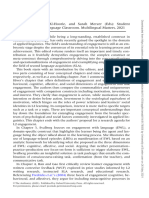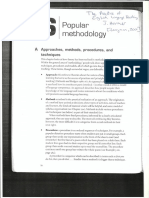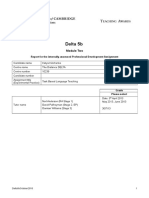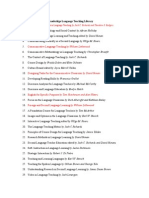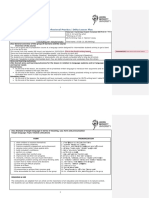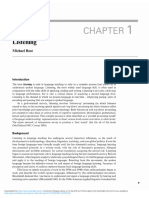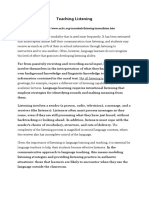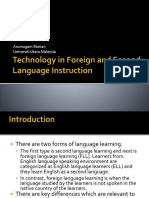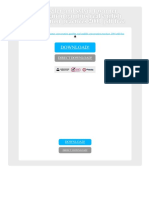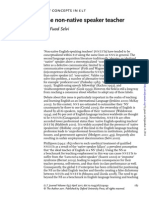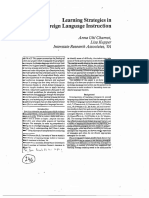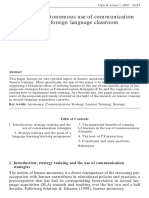0 ratings0% found this document useful (0 votes) 284 views23 pagesStrategies in Learning and Use A Second Language PDF
Copyright
© © All Rights Reserved
We take content rights seriously. If you suspect this is your content,
claim it here.
Available Formats
Download as PDF or read online on Scribd
STRATEGIES IN LEARNING
PUD RON IN(Cw LN
SECOND LANGUAGE
Andrew D. Cohen�4 Strategy training for learners and
the role of the teacher
4. Introduction
‘This chapter will focus on strategy training, starting with « broad-ranging
discussion of the various forms it cam teke and then considering the
possible res thatthe teacher can play, Inthe next chapter, we will lok
a the research literature on strstegy training and consider an experimental
study which mvestgnted the impact of stategis-based anstruction on
speaking a foreign language.
“The underiyig premise is that language caring wil be fitted if
students become more aware ofthe range of possible strategies that they
can consciously seeet during language learning and language use. The
view faken 38 that the most efficient way for learner awareness to be
heightened ss by having teachers provide stratepies-based instruction to
students asa part of the foreign language curriculum. A variety of ap-
proaches to providing studeat-directed language learning and lnguage
use strategy instruction ae discussed. Suggestions are given for develop
ing in-service strategy trang seminars for foreign language instructors,
snd a step-by-step approach to the design of strategy Uaining programs
1s presented
Section 43 focuses on the role of the teacher in stategies-based
instruction. The positon taken is that teacher traming institutions may
Wish to reconsider language teacher soles forthe twenty-first century in
their teacher educanon programs. Given this modest but growing ten-
dency among language educators to view teachers not only as language
instructors but aso as learner trams, teacher trang programs may
benefit from a unston the effective use of language learning and langusge
tse strategies. In this section, attention 1s gwen to roles that language
teachers might wish to consider assuring mn the clssroom if they are
interested in smproving the learners’ use of strategies for learning and
using the language. Such roles eau include: diagnastisan, learner trainer,
coach, coordinator, language learner, and researcher.�66 Strategies on Learning and Using a Second Language
42. Making strategy training a reality in the foreign
language curriculum,
Susan J. Weaver and Andrew Cohen’
During the last few decades, there has been a marked shift in the focus of
language instruction, toward the needs of individval learners. Language
teachers have begun to accommodate individual learners sn the classroom
by attempting to meet their various linguistic, commuueative, and socio
‘cultural goals, while a the same time adapting their instruction to meet
the students” differing language learning needs. In general, the philo-
sophy of foreign language instruction has changed to one which is more
interactive and communicative, and less static and teacher-centered. The
‘domain’ of language teaching has thus been brozdened (Tarone and
Yule, 1989; 20),
inherent im this shift an focus is also a shift in the responsibilities of
both teachers and students in the foreign language classroam. No longer
does the teacher act asthe locus ofall instruction, controlling every aspect
of the learning process, Rather, the learners themselves now, more than
ever, are sharing the responsibilty for successful language aequsstion
and, in doing 0, are becoming less dependent on the language teacher
for mecting their own individual language Icarning needs. By giving the
students more responsibility for their own language development, lan
sage programs are snviting the leamers to become more autonomous,
{ diagnose some of thesr own learning strengths and wealmesses, and to
selfsdirect the process of language development. In other words, learners
are being encouraged to ‘learn how to learn’ and ‘learn how to use’ a
foreign language in variety of instructional programs around the world
Given these changes, should language learners be left to their own
devices oF should they receive some form of training in how to learn a
foreign language? Our point of view is that learning will be facilitated if
students are explicitly trained to become more aware of and proficient
im the use of a broad range of strategies that can be utilized throughout
the language learning process. When strategy training is meluded in the
instructional package, students can learn how to learn a foreign language
‘while they are learning the language content, Students can improve both
their learning skills and thetr language skills when they are provided with
the necessary tools to:
(1) self diagnose their strengths and weaknesses in language learning;
{@) become more aware of what helps them to learn the language they are
studying most efficient
(3) develop a broad range of problem-solving skills;
(4) experiment with both familiar and unfamiliar learning strategies:
Strategy sraming for learners and the role of the teacher 67
(3) make decisions about how to approach a language task;
(©) monitor and self-evaluate their performance; and
() wansfer successful strategies to new learning contexts,
‘The process is one of having learners take responsibility for their own
learning. ‘The language instructor is then in the role of supporting the
learners as they reach thetr personal learning goals, and language learning
really becomes a team effort
Foreign language program administrators ean contribute to this effort
by offering strategy training to students as part of the forexgn language
curriculum. Strategy tram, i¢. explicitly teaching students how to apply
language learmng and language use strategies,’ can enhance students’
cffor's to teach language program goals because it encourages students
to find their own pathways to success, and thus it promotes learner
autosomy and self-direction. Strategy traming is now practiced in many
locations around the world, in programs with both ample and with lim-
ited resources, in programs that cater to learners at all levels ofthe curric=
‘lum, and im a vaniety of formats with differmg degrecs of integration
into the regular curriculum (see Oxford and Leaver, 1996)
Not only are the results of research now indicating that both more
successful and less successful learners at any level of proficiency can learn
how to smprove their comprehension and production of a foreign Jane
guage,’ but in addition it would appear that ~ at least at the outset —
explicit instruction in the development, applicauon, and transfer of
language learning strategies 1s preferable to implicit instruction. In this
section of the chapter we will examine several aspects of explicit strategy
training that can be applied to the context of university-level foreign
language programs. We will:
(1) describe the goals of strategy training for foreign languages;
(2) discuss insights from L1 and L2 research regarding strategy trang;
(G) outline seven ways to provide strategy tramings
(4) present suggestions for developing strategies-based instruction (SBI)
seminars for foreign language teachers;
(6) consider evatustive research on strategy training programs; and
(©) conctuce with a step-by-step approach to the design of strategy train-
ing programs.
4.2.1 Goals of strategy training for foreign languages
Strategies for foreign languages cam be categorized according to their
:ntended function as either language learning strategies and language use
strategies, In Chapter 2, language learner strategies Were defined as those

